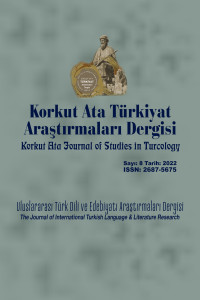Kodaly Müzik Eğitim Yönteminde Milli Bilinç ve Şuur
Bu çalışmada; ünlü besteci ve akademisyen, Macar müzik insanı Zoltan Kodaly’nin geliştirmiş olduğu Kodaly eğitim yaklaşımı, bu yaklaşımda kullanılan yöntem ve metotlar ele alınarak Kodaly’nin geliştirmiş olduğu müzik eğitimi yönteminin esaslarına değinilmiştir. Kodaly’nin bu yaklaşımda kullanmış olduğu melodilerin ve şarkıların Macar müzik eğitiminde ve Macar eğitim sisteminde yaratmış olduğu milli bilinç ve şuur etkisi araştırılmıştır. Macar müzik eğitiminin ancak Macaristan’ın milli ezgileri ve şarkıları ile başarılı olacağını düşünen Zoltan Kodaly geliştirdiği yöntemin merkezine Macar milli ezgilerini koymayı hedeflemiş ve bu şekilde hem Macar müzik eğitiminin hem de Macar eğitim sisteminin milli bir şuurla gelişmesini sağlamış ve bu hedefinde başarılı olmuştur. Macaristan’ın müzik eğitimindeki başarısında Zoltan Kodaly’nin büyük etkisi olduğu, bu etkinin Macaristan’ın tüm eğitim modeline yansıdığı örneklerle ortaya koyulmaya çalışılmıştır. Buradan hareketle binlerce yıllık tarihi, kültürü ve müziği (musikisi) olan Türkiye’nin de, müzik eğitiminde ve eğitim sisteminde milli bilinç ve şuur bilinci ile kendi dokusuna uygun bir eğitim modelini geliştirmesinin önemine değinilerek bir takım önerilerde bulunulmuştur.
Anahtar Kelimeler:
Kodaly, müzik öğretimi, yaklaşım, halk şarkıları, milli bilinç.
National Consciousness and Consciousness in the Kodaly Music Education Method
In this study, famous composer and academic; The Kodaly education approach developed by Hungarian music person Zoltan Kodaly and the methods and methods used in this approach are discussed and the principles of the music education method developed by Kodaly are metioned. The effect of national consciousness and consciosness created by the melodies and songs that Kodalyused in this approach in Hungarian music education and Hungarian education system has been investigated. Zoltan Kodaly, who thought that Hungarian music education and Hungarian education would only be successful with the national melodies and songs of Hungary, aimed to put Hungarian national melodies at the center of the method he developed, and this way, he ensured the development of both Hungarian music educaiton and Hungarian education system with a natonal consciousness and was successful. It has been tried to demonstrate with exapmles that Zoltan Kodaly had a great influence on the success on Hungary in music education and that this influence was reflected in yhe whole education model of Hungary. From this point of view, some suggestions were made by emhasizing the importance of Turkey which has thousands of years history, culture and music, to develop an education model suitable fir its own texture, with national consciousness in its music education and education system.
Keywords:
Kodaly, music teaching, approach, folk songs, national consciousness.,
___
- Alexander, L. (1971). Kodaly and Education: a Musicologial Note Author(s). College Music Symposiom, 6(11), 60-65.
- Aydın, R. (2018). Ulus, Uluslaşma ve Devlet: Bir Modern Kavram Olarak Ulus Devlet. Marmara Üniversitesi Sosyal Bilimler Dergisi, 6(1), 229-256.
- Banks, S. (1982). Orff Schulwerk Teaches Musical Responsiveness. Music Educators Journal, 68(7), 42-43.
- Devries, P. (2001). Common Kodaly Practices. Music Educators Journal, 88(3), 24-27.
- Eren, E. (2018). Ulus Devletlerde Toplumsal, Kültürel ve Siyasi Bir Etmen Olarak Kimlik Algısı: Türkiye Bağlamında Ulusal Kimlik Merkezi Dil ve Eğitim Politikaları. Turkish Studies Economies, Finance and Politics, 13(22), 225-237.
- Houlahan, M., Tacka, P. (2015). Kodaly Today, A Cognitive Approach Elementary Music Education. Oxford University Press, United States of America.
- Hurwitz, I., Wolff, P.H., Bortnick, B.D., Kokas, K. (1975). Nonmusical Effects of the Kodaly Music Curriculum in Primary Grade Children. Journal of Learning Disabilities, 8(3), 167-174.
- Jacobi, B. S. (2O11). Kodály, Literacy, and the Brain: Preparing Young Music Students to Read Pitch on the Staff. General Music Today, 25(2), 11-18.
- Jolly, C. (1967). A Personel View. Tempo (Winter), 83(6), 16-19.
- Karasar, N. (2012). Bilimsel Araştırma Yöntemi (23. Baskı). Ankara: Nobel Yayıncılık.
- Kodaly, Z. (1967). Folk Song in Pedagogy, Music Educators Journal, 53(7), 59-61.
- Milli Eğitim Temel Kanunu, https://www.mevzuat.gov.tr/mevzuatmetin/1.5.1739.pdf [Erişim Tarihi: 02.01.2023].
- Özeke, S. (2007). Kodaly Yöntemi ve İlköğretim Müzik Derslerinde Kodaly Yöntemi Uygulamaları. Uludağ Üniversitesi Eğitim Fakültesi Dergisi, 20(1), 111- 119.
- Richards, M. H. (1966). The Kodaly System in the Elementary Schools. Bulletin of the Council for Research in Music Education, 8(6), 44-48.
- Ringer, L. A. (1971). Kodaly and Education: A Musicological Note. College Music Symposiom, College Music Society, 11, 60 65.
- Shen, A. (1994). Teacher Education and National Development in China Reform of Education and The Frustrations of Implementation. The Journal of Education, 176 (2), 57-71.
- Szalbolcsi, B. (1972). Zoltan Kodaly. Studia Musicologica Academia Scientirarum Hungaricae, 14(4), 5-9.
- Şimsek, R. P. ve Bilen, S. (2017). Etkili Müzik Okur Yazarlığa Ulaşmak: Kodaly Yöntemi. International Journal of Human Sciences, 14(4), 4308-4319.
- Türkmen, E. F. (2017). Müzik Eğitiminde Öğretim Yöntemleri.Ankara: Pegem Yayıncılık.
- Vikar, L. (1999). Zoltan Kodaly, Head of Hungarian Folk Music Research, Studia Musicologica Academia Scientirarum Hungaricae, 40(3), 225-247.
- Yıldırım, K. (1995). Kodaly Yöntemi ile Müzik Eğitimi. Yüksek Lisans Tezi. İzmir: Dokuz Eylül Üniversitesi, Sosyal Bilimler Enstitüsü.
- Yılmazok, L. (2018). Ulusal Sinema: Ulus, Kültür, Kimlik ve Karakter Üzerinden Bir İnceleme. Beykoz Akademi Dergisi, 6(1), 136-151.
- Yiğit, E. F. (2000). Müzik Eğitiminde Kodaly Metodunun Rolü. Yüksek Lisans Tezi. İzmir: Dokuz Eylül Üniversitesi.
- Başlangıç: 2019
- Yayıncı: Yunus KAPLAN
Sayıdaki Diğer Makaleler
Dijital Hikâyelerin Çocuklar Üzerindeki Etkileri: Ebeveynler Ne Düşünüyor?
Antepli Aynî Divanı’ndan Bir Tarih Manzumesi ile Bu Manzumenin Bağlamlı Dizini ve İşlevsel Sözlüğü
Öz Türkçe Tartışmalarına Türkçe Dergisi Üzerinden Bakmak
Hatice ÇARLI, Bahanur GARAN GÖKŞEN
Türkiye Türkçesi Ağızlarında “Topallık” Kavram Alanı
Türk Sözlü Kültürü ve Çocuk Edebiyatı
Kara Fazlî Divanı’ndaki Tasavvuf Istılahları Üzerine Bir Değerlendirme
Keman Eğitiminde Fizyolojik Rahatsızlığı Bulunan Bireylere Alternatif Parmak Numarası Yaklaşımı
Fuzûlî’nin Türkçe Divan’ında ve Shakespeare’in Sonelerinde Aşk Teması
Destanın Yeniden İnşası: Manas Destanı’nın Ibırayım Abdırahmanov Varyantı Üzerine Bazı Tespitler
